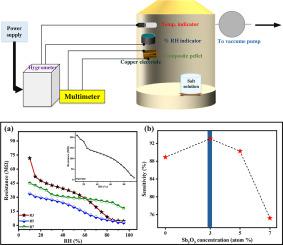Unveiling enhanced humidity sensing in Sb2O3 doped α-Fe2O3 composites
IF 4.9
3区 工程技术
Q2 ENGINEERING, ELECTRICAL & ELECTRONIC
引用次数: 0
Abstract
In this study, highly sensitive, and relative humidity ( RH) sensing material based on -Fe2O3-Sb2O3 composite is demonstrated. The composites were prepared using the conventional solid-state reaction route with different atomic weight concentrations of Sb2O3 in -Fe2O3 (0, 3, 5 & 7%) to assess its impact on humidity sensing. The structural and optical properties of these composites were investigated using X-ray diffraction (XRD), scanning electron microscopy (SEM), Raman spectroscopy, FTIR spectroscopy, and UV–Vis diffuse reflectance spectroscopy. XRD and Raman showed the multiphase nature of these composites. The band gap of the composites increased with the Sb content. These compounds exhibited humidity sensitivity greater than 88% for a lower Sb content. SEM revealed that the porous structure and large surface area of that composite facilitated better interaction with water molecules, which was the key to this improved performance. These results indicate that 3 wt% Sb2O3 significantly enhances the humidity-sensing efficiency of -Fe2O3, making it an optimal candidate for the development of efficient humidity sensors.

揭示Sb2O3掺杂α-Fe2O3复合材料增强的湿度传感
本研究展示了基于α-Fe2O3-Sb2O3复合材料的高灵敏度相对湿度(% RH)传感材料。在α-Fe2O3(0、3、5和7%)中加入不同原子质量浓度的Sb2O3,采用常规固相反应制备复合材料,以评估其对湿度传感的影响。采用x射线衍射(XRD)、扫描电镜(SEM)、拉曼光谱(Raman spectroscopy)、红外光谱(FTIR spectroscopy)和紫外可见漫反射光谱(UV-Vis漫反射spectroscopy)研究了复合材料的结构和光学性能。XRD和Raman表征了复合材料的多相性质。复合材料的带隙随Sb含量的增加而增大。这些化合物对Sb含量较低的湿度敏感性大于88%。扫描电镜显示,该复合材料的多孔结构和大表面积有助于与水分子更好地相互作用,这是提高性能的关键。结果表明,3 wt%的Sb2O3显著提高了α-Fe2O3的湿度传感效率,是开发高效湿度传感器的最佳候选材料。
本文章由计算机程序翻译,如有差异,请以英文原文为准。
求助全文
约1分钟内获得全文
求助全文
来源期刊

Sensors and Actuators A-physical
工程技术-工程:电子与电气
CiteScore
8.10
自引率
6.50%
发文量
630
审稿时长
49 days
期刊介绍:
Sensors and Actuators A: Physical brings together multidisciplinary interests in one journal entirely devoted to disseminating information on all aspects of research and development of solid-state devices for transducing physical signals. Sensors and Actuators A: Physical regularly publishes original papers, letters to the Editors and from time to time invited review articles within the following device areas:
• Fundamentals and Physics, such as: classification of effects, physical effects, measurement theory, modelling of sensors, measurement standards, measurement errors, units and constants, time and frequency measurement. Modeling papers should bring new modeling techniques to the field and be supported by experimental results.
• Materials and their Processing, such as: piezoelectric materials, polymers, metal oxides, III-V and II-VI semiconductors, thick and thin films, optical glass fibres, amorphous, polycrystalline and monocrystalline silicon.
• Optoelectronic sensors, such as: photovoltaic diodes, photoconductors, photodiodes, phototransistors, positron-sensitive photodetectors, optoisolators, photodiode arrays, charge-coupled devices, light-emitting diodes, injection lasers and liquid-crystal displays.
• Mechanical sensors, such as: metallic, thin-film and semiconductor strain gauges, diffused silicon pressure sensors, silicon accelerometers, solid-state displacement transducers, piezo junction devices, piezoelectric field-effect transducers (PiFETs), tunnel-diode strain sensors, surface acoustic wave devices, silicon micromechanical switches, solid-state flow meters and electronic flow controllers.
Etc...
 求助内容:
求助内容: 应助结果提醒方式:
应助结果提醒方式:


